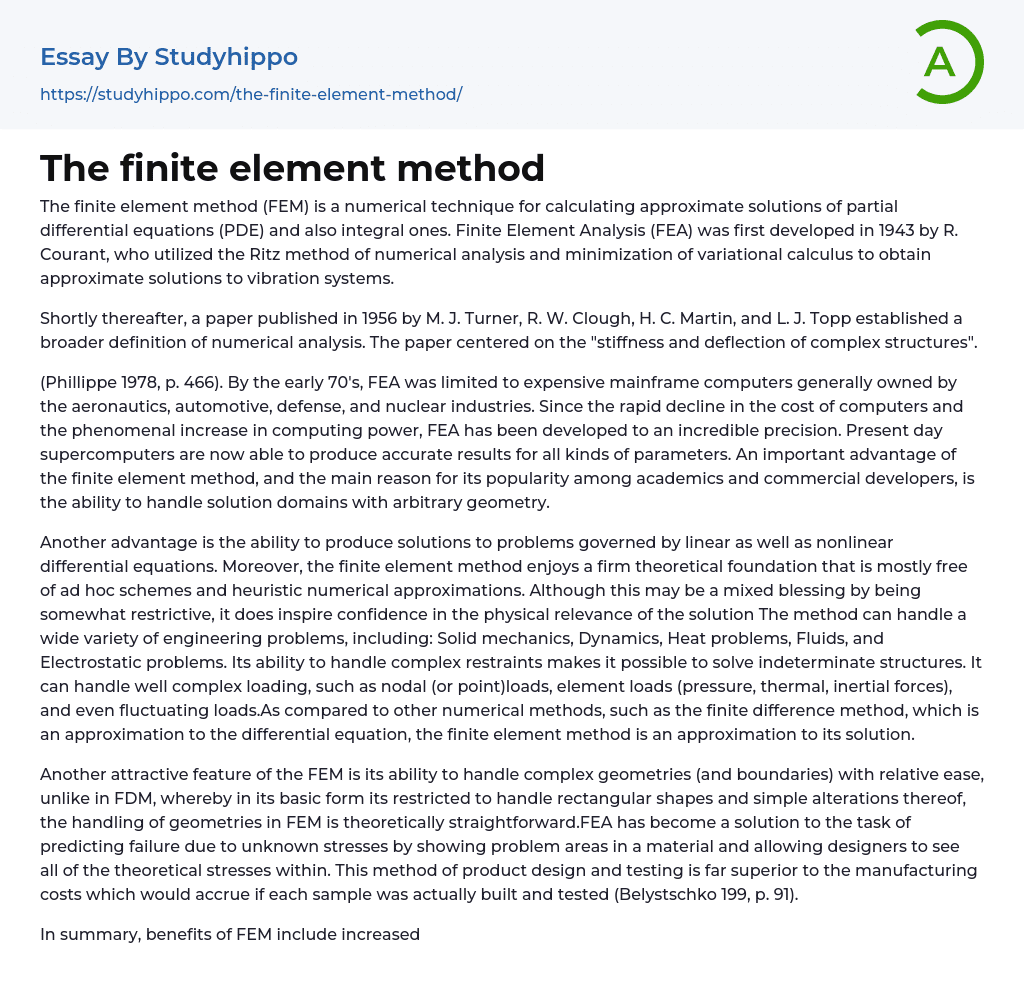The finite element method (FEM) is a numerical technique for calculating approximate solutions of partial differential equations (PDE) and also integral ones. Finite Element Analysis (FEA) was first developed in 1943 by R. Courant, who utilized the Ritz method of numerical analysis and minimization of variational calculus to obtain approximate solutions to vibration systems.
Shortly thereafter, a paper published in 1956 by M. J. Turner, R. W. Clough, H. C. Martin, and L. J. Topp established a broader definition of numerical analysis. The paper centered on the "stiffness and deflection of complex structures".
(Phillippe 1978, p. 466). By the early 70's, FEA was limited to expensive mainframe computers generally owned by the aeronautics, automotive, defense, and nuclear industries. Since the rapid decline in the cost of computers and the phenomenal increase in computing power, FEA has been developed to an incredible
...precision. Present day supercomputers are now able to produce accurate results for all kinds of parameters. An important advantage of the finite element method, and the main reason for its popularity among academics and commercial developers, is the ability to handle solution domains with arbitrary geometry.
Another advantage is the ability to produce solutions to problems governed by linear as well as nonlinear differential equations. Moreover, the finite element method enjoys a firm theoretical foundation that is mostly free of ad hoc schemes and heuristic numerical approximations. Although this may be a mixed blessing by being somewhat restrictive, it does inspire confidence in the physical relevance of the solution The method can handle a wide variety of engineering problems, including: Solid mechanics, Dynamics, Heat problems, Fluids, and Electrostatic problems. Its ability to handle complex restraints makes it
possible to solve indeterminate structures. It can handle well complex loading, such as nodal (or point)loads, element loads (pressure, thermal, inertial forces), and even fluctuating loads.As compared to other numerical methods, such as the finite difference method, which is an approximation to the differential equation, the finite element method is an approximation to its solution.
Another attractive feature of the FEM is its ability to handle complex geometries (and boundaries) with relative ease, unlike in FDM, whereby in its basic form its restricted to handle rectangular shapes and simple alterations thereof, the handling of geometries in FEM is theoretically straightforward.FEA has become a solution to the task of predicting failure due to unknown stresses by showing problem areas in a material and allowing designers to see all of the theoretical stresses within. This method of product design and testing is far superior to the manufacturing costs which would accrue if each sample was actually built and tested (Belystschko 199, p. 91).
In summary, benefits of FEM include increased accuracy, enhanced design and better insight into critical design parameters, virtual prototyping, fewer hardware prototypes, a faster and less expensive design cycle, increased productivity, and increased revenue. This method, however, has a number of drawbacks. A general closed-form solution, which would permit one to examine system response to changes in various parameters, is not produced. The method is only capable of obtaining "approximate" solutions, not the exact ones. It also has errors that can be termed "inherent". Even the slightest mistakes by users of the method in manipulation can be fatal. (Shaw 1975, p. 398). Although the quality of a FEM approximation is often quite high as compared to
other methods, it is worth noting that this highly depends on a particular problem, and a number of examples to the contrary can be proven. In solving partial differential equations, the primary challenge is to create an equation that approximates the equation to be studied, but is numerically stable, meaning that errors in the input data and intermediate calculations do not accumulate and cause the resulting output to be meaningless. There are many ways of doing this, all with advantages and disadvantages.
The Finite Element Method is a good choice for solving partial differential equations over complex domains (like cars and oil pipelines), when the domain changes (as during a solid state reaction with a moving boundary), when the desired precision varies over the entire domain, or when the solution lacks smoothness. For instance, in a frontal crash simulation it is possible to increase prediction accuracy in "important" areas like the front of the car and reduce it in its rear (thus reducing cost of the simulation); Another example would be the simulation of the weather pattern on Earth, where it is more important to have accurate predictions over land than over the wide-open sea.
- Correlation essays
- Price Elasticity Of Demand essays
- Algebra essays
- Arithmetic essays
- Statistics essays
- Measurement essays
- Geometry essays
- Regression Analysis essays
- Derivative essays
- Integral essays
- Mean essays
- Normal Distribution essays
- Probability Theory essays
- Variance essays
- Cycle essays
- Shape essays
- Energy essays
- Density essays
- Thermodynamics essays
- Motion essays
- Atom essays
- Sound essays
- Electricity essays
- Nuclear Power essays
- Temperature essays
- Physiology essays
- Light essays
- Force essays
- Heat essays
- Speed essays
- Big Bang Theory essays
- Energy Development essays
- The elements essays
- Voltage essays
- Solar Energy essays
- Nuclear Energy essays
- Alternative Energy essays
- Melting essays
- Nuclear Family essays
- John Locke essays
- 9/11 essays
- A Good Teacher essays
- A Healthy Diet essays
- A Modest Proposal essays
- A&P essays
- Academic Achievement essays
- Achievement essays
- Achieving goals essays
- Admission essays
- Advantages And Disadvantages Of Internet essays




